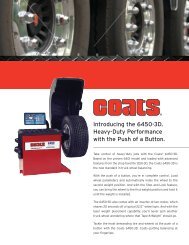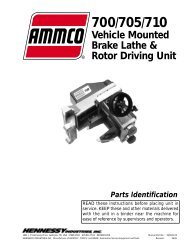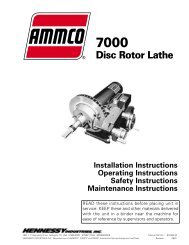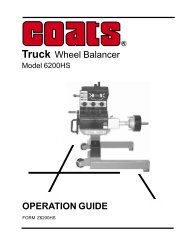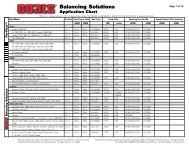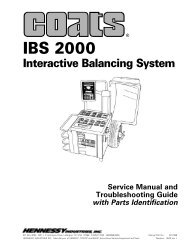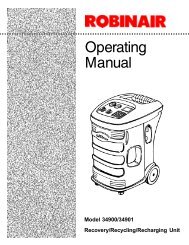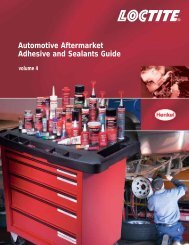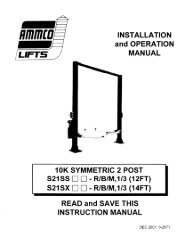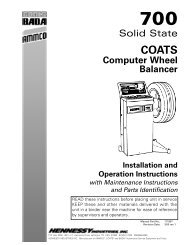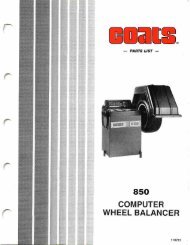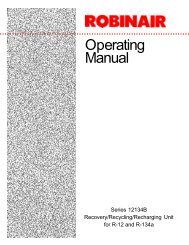Robinair 34134-2K 134a Recovery Unit - NY Tech Supply
Robinair 34134-2K 134a Recovery Unit - NY Tech Supply
Robinair 34134-2K 134a Recovery Unit - NY Tech Supply
You also want an ePaper? Increase the reach of your titles
YUMPU automatically turns print PDFs into web optimized ePapers that Google loves.
LISTED<br />
80S2<br />
Recycling Equipment Design<br />
Certified by Underwriters<br />
Laboratories Inc.® for<br />
Compliance with SAE-J2210<br />
(1991) for HFC-<strong>134a</strong><br />
Refrigerant <strong>Recovery</strong>,<br />
Recycling and Recharging Station<br />
Series: <strong>34134</strong>-<strong>2K</strong><br />
Refrigerants: R-<strong>134a</strong><br />
SAFETY DEFINITIONS: Follow all WARNING, CAUTION, IMPORTANT, and NOTE messages in this manual. These<br />
messages are defined as follows: WARNING means you may risk serious personal injury or death; CAUTION means<br />
you may risk personal injury, property damage, or serious unit damage; IMPORTANT means you may risk unit damage;<br />
and NOTEs provide clarity and helpful tips. These safety messages cover situations ROBINAIR is aware of. ROBINAIR<br />
cannot know, evaluate, and advise you as to all possible hazards. You must make sure all conditions and procedures do<br />
not jeopardize your personal safety.<br />
COPYRIGHT: No part of this manual may be reproduced, stored in a retrieval system, or transmitted in any form or by<br />
any means (electronic, mechanical, photocopy, recorded, or otherwise) without the prior written permission of ROBINAIR.<br />
DISCLAIMER: All information, illustrations, and specifications contained in this manual are based on the latest<br />
information available at the time of publication. The right is reserved to make changes at any time without obligation to<br />
notify any person or organization of such revisions or changes. Further, ROBINAIR shall not be liable for errors contained<br />
herein or for incidental or consequential damages (including lost profits) in connection with the furnishing, performance, or<br />
use of this material. If necessary, obtain additional health and safety information from the appropriate government<br />
agencies and the vehicle, refrigerant, and lubricant manufacturers.<br />
WARNINGS<br />
ALLOW ONLY QUALIFIED PERSONNEL TO OPERATE THE UNIT. Before operating the unit, read and follow<br />
the instructions and warnings in this manual. The operator must be a certified technician and must be familiar with<br />
air conditioning and refrigeration systems, refrigerants, and the dangers of pressurized components. If the<br />
operator cannot read English, operating instructions and safety precautions must be read and discussed in the<br />
operator’s native language.<br />
Si el operador no puede leer el inglés, las instrucciones de operación y las precauciones de seguridad deberán<br />
leerse y comentarse en el idioma nativo del operador.<br />
Si l’utilisateur ne peut lire l’anglais, les instructions et les consignes de sécurité doivent lui être expliquées dans sa<br />
langue maternelle.<br />
PRESSURIZED TANK CONTAINS LIQUID REFRIGERANT. Do not overfill the internal storage vessel because<br />
overfilling may cause explosion and serious personal injury or death. Do not recover or charge refrigerants into<br />
non-refillable containers; use only federally authorized refillable containers.<br />
ALL HOSES MAY CONTAIN LIQUID REFRIGERANT UNDER PRESSURE. Contact with refrigerant may cause<br />
personal injury. Wear correct protective equipment, including safety goggles. Disconnect hoses with extreme<br />
caution.<br />
HIGH VOLTAGE ELECTRICITY INSIDE THE UNIT HAS A RISK OF ELECTRICAL SHOCK. Exposure may<br />
cause personal injury. Refer to the instruction manual for correct procedure when disconnecting the power.<br />
TO REDUCE THE RISK OF FIRE, do not use the unit in the vicinity of spilled or open containers of gasoline or<br />
other flammable substances. An extension cord may overheat and cause fire. If an extension cord is needed, use<br />
the shortest possible cord with a minimum size of No. 14 AWG.<br />
DO NOT BREATH REFRIGERANT. Exposure may cause personal injury, especially to the eyes, nose, throat, and<br />
lungs. Use this equipment in locations with mechanical ventilation that provides at least four air changes per hour<br />
or locate the equipment at least 18 inches above the floor. If accidental system discharge occurs, ventilate the<br />
work area before resuming service.<br />
USE THE UNIT WITH ONLY R-<strong>134a</strong> REFRIGERANT. The unit is for recovering, recycling, and recharging only<br />
R-<strong>134a</strong> refrigerant! Do not attempt to adapt the unit for another refrigerant. Do not mix refrigerant types through a<br />
system or in the same container; mixing of refrigerants will cause severe damage to the unit and the vehicle air<br />
conditioning system.<br />
DO NOT USE COMPRESSED AIR TO PRESSURE TEST OR LEAK TEST THE UNIT OR VEHICLE AIR<br />
CONDITIONING SYSTEM. Some mixtures of air and R-<strong>134a</strong> refrigerant are combustible at elevated pressures.<br />
These mixtures are potentially dangerous and may result in fire or explosion causing personal injury or property<br />
damage.<br />
Additional health and safety information may be obtained from refrigerant and lubricant manufacturers.<br />
This equipment is protected by one or more of the following patents: US: 4,938,031; 5,005,369; 5,248,125; 4,261,178;<br />
4,768,347. Other U.S. and Foreign Patents Pending.



